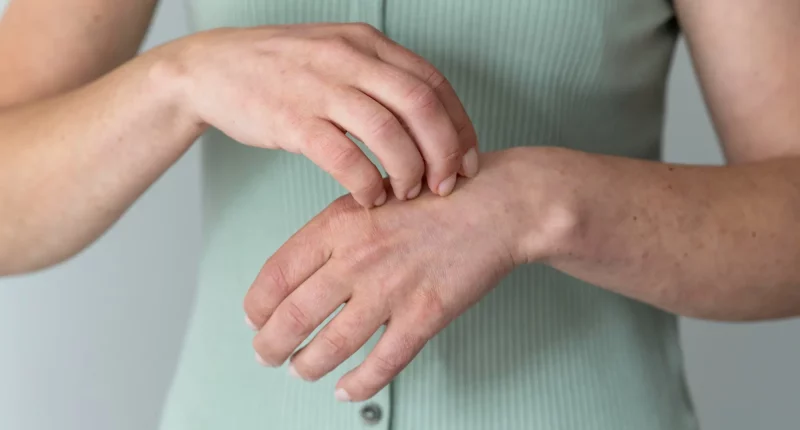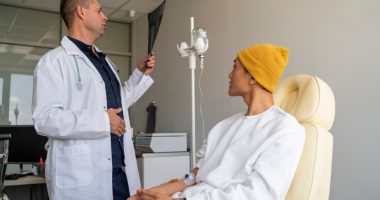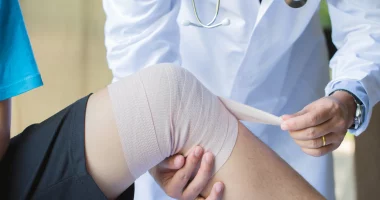Blastomycosis is a fungal infection caused by Blastomyces gilchristii fungi or Blastomyces dermatitidis, which are not common. Symptoms like cough, fever, and night sweats may appear in some people who get infected.
Healthcare providers might suggest antifungal drugs to diagnosis blastomycosis. The kind of medication they recommend depends on how serious the infection is.
Causes
Blastomycosis is caused by inhaling spores of the Blastomyces gilchristii fungus or Blastomyces dermatitidis. These fungi live in decomposing leaves, moist soil, or wood. People usually breathe in the spores while doing activities like digging or working in construction or excavation areas.
In about 25–30% of individuals with blastomycosis, the disease can spread from the lungs to other parts of the body, often affecting the skin.
Is blastomycosis dangerous?
Blastomycosis usually does not spread from person to person or from animal to person, so it’s not considered contagious.
However, according to the Centers for Disease Control and Prevention (CDC), there have been very rare cases where blastomycosis may spread through a needlestick injury, a bite, or sexual contact.
Symptoms
Blastomycosis symptoms usually appear in about 50% of those who are infected. It can take between 3 weeks to 3 months after being exposed to the fungus for symptoms to show up, although they might start earlier or later than this timeframe.
When symptoms do appear, they can vary widely. Common signs include a persistent fever, cough, joint and muscle pain, chills, night sweats, and unexplained weight loss. Extreme tiredness and chest aches may also occur, and in some cases, people may cough up blood from their respiratory tract, a condition known as hemoptysis. Additionally, skin problems like ulcers or blisters might develop.
Since blastomycosis symptoms can mimic other illnesses, such as flu or pneumonia, it’s important to consult a healthcare provider for an accurate diagnosis if these symptoms occur, especially after potential exposure to environments where the fungus is present. Early detection and treatment can help manage the infection effectively.
Diagnosis
Diagnosing blastomycosis starts with a doctor gathering information about the patient’s medical history, inquiring about symptoms, and conducting a physical examination.
Since blastomycosis is more common in certain regions of the US like the South Central, Midwestern, and Southeastern states, doctors may also inquire about recent travel history to these areas.
To confirm the diagnosis or eliminate other conditions, the doctor may order several tests. These can include a chest X-ray or a CT scan to look for signs of infection. A tissue biopsy, where a small sample of affected tissue is taken for examination under a microscope, or collecting fluid from the respiratory tract may also be necessary.
These tests help doctors accurately diagnose blastomycosis and determine the best course of treatment. If you suspect you have blastomycosis or have been in areas where the fungus is common and develop symptoms, it’s essential to seek medical attention promptly.
Treatment
Treating blastomycosis depends on how severe the infection is.
For mild to moderate cases, doctors often prescribe a medicine called itraconazole, which fights against the fungus causing the infection.
In more serious cases, or if the infection has infected beyond the lungs, doctors may suggest a stronger medication called amphotericin B.
Treatment for blastomycosis can take quite a while, typically lasting from 6 months to 12 months, according to the CDC. It’s important to follow the doctor’s advice carefully to make sure the infection clears up completely.
Prevention
Preventing blastomycosis primarily involves avoiding exposure to the fungus in parts where it is normal, such as particular regions in the United States like Mississippi, Wisconsin, and others. Here are some prevention tips:
- Avoiding High-Risk Activities: Reduce activities that disturb moist soil or decaying wood, such as clearing wood, digging, or construction work, especially in endemic areas.
- Protective Clothing: When engaging in outdoor activities in endemic regions, wear protective clothing such as long sleeves, gloves, and masks to reduce inhalation of fungal spores.
- Awareness of Symptoms: Be aware of the signs of blastomycosis, such as continuous fever, cough, and skin lesions, especially if you live or have recently traveled to endemic areas.
- Prompt Medical Attention: Seek medical attention promptly if you suspect you may have blastomycosis, particularly after potential exposure. Early diagnosis and treatment can stop complications.
- Pet Care: Be cautious with pets that may have been exposed to blastomycosis, as they can carry the fungus. Consult a veterinarian if you suspect your pet may be infected.
Following these precautions can help reduce the risk of contracting blastomycosis in endemic areas.
How common is it?
Blastomycosis is not very common, affecting about 1 to 2 out of every 100,000 individuals each year in certain states where it’s more prevalent. These states include Mississippi, Wisconsin, Arkansas, and Kentucky.
Cases are also reported in other states like Tennessee, North Carolina, Louisiana, Minnesota, Illinois, and Michigan. Wisconsin sees the most cases, especially in its northern counties where the incidence can be as high as 10 to 40 cases per 100,000 people annually.
Complications
Blastomycosis can lead to several complications if not treated promptly. The infection can spread beyond the lungs to other organs like the skin, bones, or even the central nervous system. This spread can result in abscesses (pockets of pus), skin sores, infection of bones, or affect the brain and spinal cord. These complications can be serious and may require specialized treatments.
Early diagnosis and starting treatment quickly are crucial to minimizing the chance of these complications. Doctors typically use tests like X-rays or biopsies to confirm blastomycosis. Once diagnosed, antifungal medications are prescribed to fight the infection. Following the treatment plan carefully can help prevent the infection from spreading and reduce the chances of developing severe complications. If anyone suspects they may have blastomycosis, seeking medical attention promptly is important for effective treatment and preventing complications.
Summary
Blastomycosis is a rare fungal infection results from inhaling spores of Blastomyces dermatitidis or Blastomyces gilchristii fungi found in decaying wood and moist soil. Symptoms, including cough, fever, and skin lesions, typically appear weeks to months after exposure. Diagnosis involves medical history, physical exams, and tests like X-rays and biopsies.
Treatment varies from itraconazole for mild cases to amphotericin B for severe infections, lasting 6 months to 1 year. Complications can include spread to other organs and require prompt treatment to prevent abscesses, bone infections, or central nervous system involvement. Prevention includes avoiding exposure in endemic areas like certain parts of the United States.









